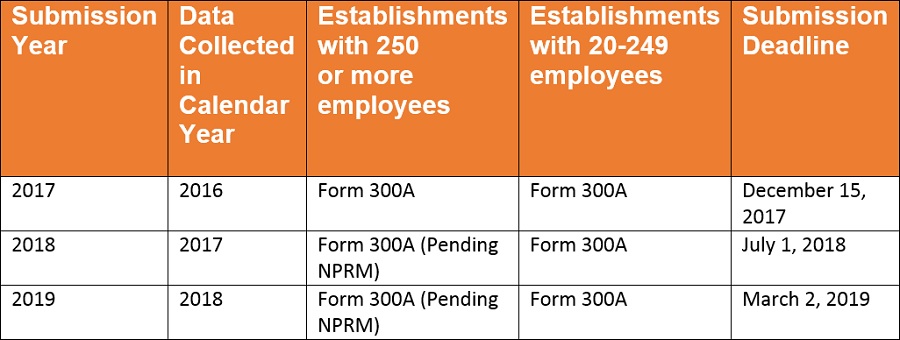In May of 2016, the Occupational Safety and Health Administration (OSHA) issued a final rule “Improve Tracking of Workplace Injuries and Illnesses” to revise its recording and reporting occupational injuries and illnesses regulation.
This ruling, which became effective on January 1, 2017, requires establishments with 250 or more employees, as well as establishments with 20 or more employees in high risk industries, to electronically submit their Form 300A data to OSHA on an annual basis using the agency’s Injury Tracking Application (ITA).
This article reviews the steps employers must take this year to comply with the rule and provides an overview of OSHA’s new policies impacting the compliance obligations of employers covered under state plans.
What data must organizations submit electronically to OSHA in 2018?
This year, all covered establishments must electronically submit 300A form data for the 2017 calendar year by July 1, 2018.
Initially, the final rule would also have required establishments with 250 or more employees to electronically submit additional injury and illness data from Forms 300 and 301 by this July 1 deadline.
However, in November of 2017, OSHA stated that it will not accept Form 300 and 301 information, and that the agency would instead issue a notice of proposed rulemaking (NPRM) to reconsider, revise, or remove provisions of the final rule, including the collection of Form 300 and Form 301 data.
OSHA had planned that the NPRM would be forthcoming in December of 2017. However, at the time this article was written, the agency was still drafting the NPRM.
This rulemaking may have stalled because OSHA is still operating under temporary leadership. While former FedEx safety executive, Scott Mugno, was nominated as Assistant Secretary of OSHA in November of 2017, to date, his confirmation by the senate is still pending and a hearing has not yet been scheduled.
Despite this delay, given the agency’s stated plans and the fact that the ITA has not been updated to even allow for the submission of 300 and 301 information, establishments should expect to only submit data from their 2017 Form 300A by the upcoming July 1 deadline.
The table below further clarifies what data will be due by the rule’s future submission deadlines. Starting in 2019 and continuing for each year thereafter, organizations must submit data collected in the previous calendar year by March 2.

New Policies for Employers under State Plans
On April 30, 2018, OSHA issued a press release correcting an implementation error that impacts the compliance obligations of employers in state-plan states.
This correction states that covered establishments in all states must now submit injury and illness data using OSHA’s ITA portal by this year’s July 1 deadline, even if an establishment is covered by a State Plan that has not completed adoption of their own state rule.
At the time this release was published, several state plans had yet to implement the electronic recordkeeping rule, including California, Maryland, Minnesota, South Carolina, Utah, Washington, and Wyoming.
Covered establishments in these states must now prepare to submit their 2017 Form 300A data using the ITA by July 1, 2018.
OSHA also clarified that state government and local government establishments operating under State Plans are required to electronically submit injury and illness information by the July 1 deadline if they otherwise meet the criteria for compliance.
What happens if an employer failed to submit their 300A data by the first filing deadline?
As shown in the table above, the final rule’s first data submission deadline was December 15, 2017, by which time all establishments covered by the ruling were expected to electronically submit their 2016 300A Form.
During the lead-up to the first submission deadline, 60,000 accounts were created within the ITA and over 214,000 300A forms were submitted. However, these submissions fell short of the number of forms that OSHA had anticipated to receive. According to the agency, a little over one-third of establishments required to file their data electronically did not comply.
The ITA ceased accepting 2016 Form 300A data on January 1, 2018. For covered employers that missed the first filing deadline, it is no longer possible to submit 2016 data.
OSHA has since issued a memorandum outlining the agency’s enforcement policy of the electronic recordkeeping rule. As part of any onsite inspection, OSHA’s compliance officers will now inquire whether an establishment has electronically filed its 2016 300A form.
If the compliance officer learns that the establishment was required to electronically submit its 300A form and failed to do so, OSHA will issue an other-than-serious citation for failing to comply with the regulation. OSHA may also pursue a full recordkeeping audit if there is evidence of potential systemic recordkeeping issues.
OSHA has until June 15, 2018 to inspect locations for violations of the rule’s first submission deadline. According to the memo, the agency is also developing an analytic approach to identify employers that did not comply with the rule.
The Bottom Line: Recommendations for Employers
OSHA’s enforcement memorandum, together with the agency’s recent policies regarding State Plans, makes it clear that the agency is committed to the electronic collection of 300A Form information.
For establishments that complied with the rule last year, submitting your 2017 Form 300A data should be straightforward, as safety professionals will already have set up their organization’s ITA account, and will be familiar with the portal.
For establishments that will be submitting their data for the first time, it’s simple and easy to create an ITA account. However, to avoid setting up duplicate accounts for your company (and to avoid the duplication of data submissions), it’s best to coordinate with your team and clearly designate which individual(s) will be responsible for using the ITA and creating an account for your organization.
You can choose between two methods to submit your recordkeeping data, manually or through a batch submission process.
For manual submissions, you first need to add your establishments to the application by creating profiles for them. Once you have set up your establishments, you can then enter and submit OSHA 300A data for each one via a web form.
For a quicker and simpler submission process, the ITA also offers the option to upload a CSV file containing 300A data for many establishments at once. This method is ideal for employers that need to submit data for multiple establishments.
The July 1 deadline is fast approaching, so all covered establishments, especially those that missed the first filing deadline, or those under state plan jurisdiction that will be complying with the rule for the first time, should begin preparing their data for electronic submission.Taking the time now to ensure that your 2017 300A data is accurate and to familiarize yourself with the ITA will help ensure a smooth submission process.



